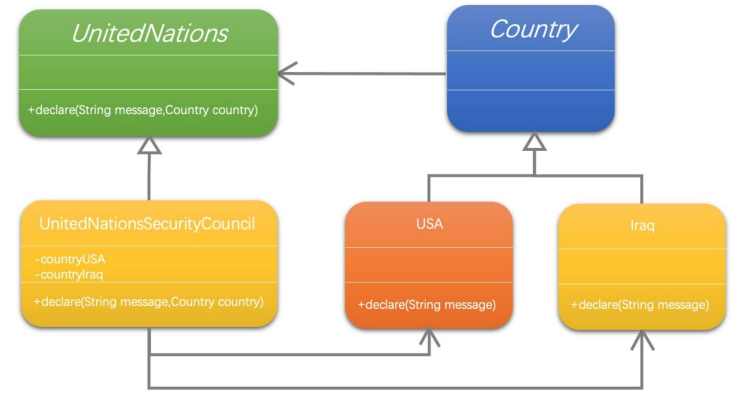中介者模式
1、中介者模式介绍
中介者模式(Mediator Pattern)是一种行为设计模式,用一个中介对象来封装一系列的对象交互。中介者使各对象不需要显式地相互引用,从而使其耦合松散,而且可以独立地改变它们之间的交互。
它用于减少对象之间的直接通信,通过引入一个中介者对象来促进对象之间的松耦合。中介者模式可以帮助组织和管理复杂的交互逻辑,使得对象之间的交互更加简单和可维护。
在中介者模式中,多个对象之间的通信不再直接发生,而是通过中介者进行。中介者对象担当了对象之间的调度者和协调者的角色,它负责接收对象之间的通信请求,并将其转发给合适的接收者对象。
1.1 中介者模式基本实现
中介者模式结构图

中介者模式的主要参与者包括以下几个角色:
- Colleague叫作抽象同事类
- ConcreteColleague是具体同事类,每个具体同事只知道自己的行为,而不了解其他同事类的情况,但他们却都认识中介者对象
- Mediator是抽象中介者,定义了同事对象到中介者对象的接口
- ConcreteMediator是具体中介者对象,实现抽象类的方法,它需要知道所有具体同事类,并从具体同事接收消息,向具体同事对象发出命令
Colleague类:抽象同事类
/*** @author Shier* CreateTime 2023/5/22 15:08*/
public abstract class Colleague {protected Mediator mediator;/*** 获取中介者对象* @param mediator*/public Colleague(Mediator mediator) {this.mediator = mediator;}
}
ConcreteColleague1和ConcreteColleague2等各种同事对象:
/*** @author Shier* CreateTime 2023/5/22 15:09*/
public class ConcreteColleague1 extends Colleague {/*** 获取中介者对象** @param mediator*/public ConcreteColleague1(Mediator mediator) {super(mediator);}/*** 发送消息* @param message*/public void send(String message) {this.mediator.send(message,this);}/*** 接受消息* @param message*/public void notify(String message) {System.out.println("同事1收到消息 " + message);}
}public class ConcreteColleague2 extends Colleague{/*** 获取中介者对象** @param mediator*/public ConcreteColleague2(Mediator mediator) {super(mediator);}/*** 发送消息* @param message*/public void send(String message) {this.mediator.send(message,this);}/*** 接受消息* @param message*/public void notify(String message) {System.out.println("同事2收到消息 " + message);}
}
Mediator类:抽象中介者类
/*** @author Shier* CreateTime 2023/5/22 15:13* 抽象中介者类*/
public abstract class Mediator {/*** 发送消息的抽象方法,得到同事对象和消息* @param message* @param colleague*/public abstract void send(String message, Colleague colleague);
}
ConcreteMediator类:具体中介者类。
/*** @author Shier* CreateTime 2023/5/22 15:15* 具体中介者类*/
public class ConcreteMediator extends Mediator {/*** 两个同事属性*/private ConcreteColleague1 colleague1;private ConcreteColleague2 colleague2;/*** 知道具体同事的对象** @param colleague1*/public void setColleague1(ConcreteColleague1 colleague1) {this.colleague1 = colleague1;}public void setColleague2(ConcreteColleague2 colleague2) {this.colleague2 = colleague2;}/*** 重写发送消息方法,根据不同具体同事对象做出判断通知其他同事* @param message* @param colleague*/@Overridepublic void send(String message, Colleague colleague) {if (colleague == colleague1) {colleague2.notify(message);} else {colleague1.notify(message);}}
}
客户端:
public class MediaClient {public static void main(String[] args) {ConcreteMediator mediator = new ConcreteMediator();// 两个具体同事都认识中介者ConcreteColleague1 colleague1 = new ConcreteColleague1(mediator);ConcreteColleague2 colleague2 = new ConcreteColleague2(mediator);// 中介者认识两个同事mediator.setColleague1(colleague1);mediator.setColleague2(colleague2);// 同事之间进行交流colleague1.send("你今晚吃饭了吗?");colleague2.send("我今晚还没有吃饭呢");}
}
输出结果:

2、具体例子说明
2.1 中介者模式 - 联合国安理会
程序结构图:

国家类:相当于Colleague类。
/*** @author Shier* CreateTime 2023/5/22 15:34* 国家类*/
public abstract class Country {protected UnitedNations unitedNations;/*** 得到安理会中介者* @param unitedNations*/public Country(UnitedNations unitedNations) {this.unitedNations = unitedNations;}
}
美国类:相当于ConcreteColleague1类。
/*** @author Shier* CreateTime 2023/5/22 15:36* 美国类*/
public class USA extends Country {/*** 得到安理会中介者** @param unitedNations*/public USA(UnitedNations unitedNations) {super(unitedNations);}/*** 美国发布消息** @param message*/public void declare(String message) {this.unitedNations.declare(message, this);}/*** 美国接受其他国家信息* @param message*/public void getMessage(String message) {System.out.println("美国收到消息:" + message);}
}
伊拉克类:相当于ConcreteColleague2类
/*** @author Shier* CreateTime 2023/5/22 15:36* 伊拉克类*/
public class Iraq extends Country {/*** 得到安理会中介者** @param unitedNations*/public Iraq(UnitedNations unitedNations) {super(unitedNations);}/*** 伊拉克发布消息** @param message*/public void declare(String message) {this.unitedNations.declare(message, this);}/*** 伊拉克接受其他国家信息* @param message*/public void getMessage(String message) {System.out.println("伊拉克收到消息:" + message);}
}
联合国机构类:相当于Mediator类。
/*** @author Shier* CreateTime 2023/5/22 15:40* 中介者*/
public abstract class UnitedNations {public abstract void declare(String message,Country country);
}
联合国安理会:相当于ConcreteMediator类。
/*** @author Shier* CreateTime 2023/5/22 15:42*/
public class UnitedNationsSecurityCouncil extends UnitedNations {private USA usa;private Iraq iraq;/*** 联合国安理会了解所有国家,所有拥有所有国家的对象属性** @param usa*/public void setUsa(USA usa) {this.usa = usa;}public void setIraq(Iraq iraq) {this.iraq = iraq;}/*** 对象间的通信* @param message* @param country*/@Overridepublic void declare(String message, Country country) {if (country == this.usa) {iraq.getMessage(message);} else if (country == this.iraq){usa.getMessage(message);}}
}
客户端调用:
/*** @author Shier* CreateTime 2023/5/22 15:44*/
public class CountryClient {public static void main(String[] args) {UnitedNationsSecurityCouncil council = new UnitedNationsSecurityCouncil();// 各个国家知道安理会存在USA usa = new USA(council);Iraq iraq = new Iraq(council);// 联合国安理会知道每个国家存在council.setUsa(usa);council.setIraq(iraq);usa.declare("不准研制核武器,否则将对你发起战争");iraq.declare("我并没有研制核武器,但你不要威胁我");}
}
结果:

3、中介者模式总结
中介者模式的优点包括:
- 减少了对象之间的直接耦合:通过引入中介者对象,各个对象之间不再直接通信,减少了彼此之间的依赖关系,提高了系统的灵活性和可扩展性。
- 简化对象之间的交互:中介者模式将对象之间的交互逻辑集中在一个对象中,使得交互变得更加简单和可维护,提高了代码的可读性。
- 提高代码的可维护性:通过将复杂的交互逻辑放在中介者对象中,使得代码更加集中和可维护,便于后续的修改和扩展。
中介者模式的缺点包括:
- 中介者对象的职责较多:中介者对象通常负责协调多个对象之间的通信,可能会导致中介者对象的职责变得复杂,难以维护和扩展。
- 增加了系统的复杂性:引入中介者对象后,系统中会多出一个新的对象,增加了系统的复杂性,特别是当交互逻辑变得复杂时。
适用场景:
- 当对象之间的通信复杂且难以维护时,可以考虑使用中介者模式来简化对象之间的交互。
- 当系统中存在多个对象之间的交互逻辑,并且这些交互逻辑需要集中管理时,可以使用中介者模式来将交互逻辑集中在中介者对象中。
- 当系统中的对象之间的关系呈现网状结构时,可以考虑使用中介者模式来简化对象之间的通信和管理。
- 当希望通过引入中介者对象来降低对象之间的耦合性,提高系统的灵活性和可扩展性时,可以使用中介者模式。
中介者模式在图形用户界面(GUI)开发、多人协作系统、企业应用中的分布式系统等场景下得到广泛应用。
通常负责协调多个对象之间的通信,可能会导致中介者对象的职责变得复杂,难以维护和扩展。
2. 增加了系统的复杂性:引入中介者对象后,系统中会多出一个新的对象,增加了系统的复杂性,特别是当交互逻辑变得复杂时。
适用场景:
- 当对象之间的通信复杂且难以维护时,可以考虑使用中介者模式来简化对象之间的交互。
- 当系统中存在多个对象之间的交互逻辑,并且这些交互逻辑需要集中管理时,可以使用中介者模式来将交互逻辑集中在中介者对象中。
- 当系统中的对象之间的关系呈现网状结构时,可以考虑使用中介者模式来简化对象之间的通信和管理。
- 当希望通过引入中介者对象来降低对象之间的耦合性,提高系统的灵活性和可扩展性时,可以使用中介者模式。
中介者模式在图形用户界面(GUI)开发、多人协作系统、企业应用中的分布式系统等场景下得到广泛应用。
本文链接:https://my.lmcjl.com/post/2779.html

4 评论